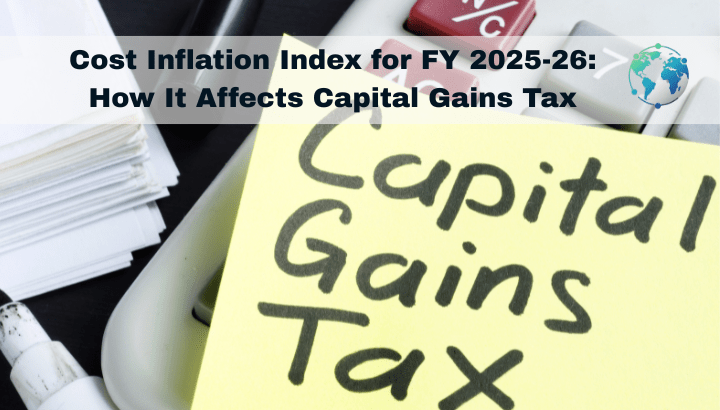If you are thinking about selling any long-term assets like gold, property, or privately held shares, then you may have to pay capital gains tax. But you should also know that you can reduce this tax using something called the Cost Inflation Index (CII). This is a very useful tool from the government that adjusts the purchase of your assets for inflation, which means you pay less tax on your gains.
For FY 2025-26, the Income Tax Department of India has revised the new Cost Inflation Index 2025-26 as 363 and if you are planning to sell any long-term capital assets between April 1, 2025 and March 31, 2026, this number is going to be very crucial.
In simple terms, let’s break it down so that you can understand how it works and how it can help you save money.
What is Cost Inflation Index (CII)?
The Cost Inflation Index (CII) is a number that the government updates every year. It mainly shows how much price or inflation have gone up over time.
It is really important for you, because when you sell long-term assets like property, gold, or unlisted assets, you can’t just compare the price you paid years ago with the selling price today. The CII helps you adjust the original purchase price to present value, which makes your capital tax smaller and capital gains lower.
- The starting year for CII is 2001-02, and its value is set at 100.
- Each year, the government issues a new CII value.
- With the higher CII, you can adjust more on your purchase cost.
CII 2025 for Capital Gains: What’s the Value?
For Financial year 2025-26, the government issued the Cost Inflation Index as 363.
- In the FY 2024-25 CII issued by the government was 348.
- This increase in CII number indicates the rise in inflation during the year.
If you are planning to sell property or other long-term assets during FY 2025-26, you will use this number to calculate your indexed cost, which can later lower your capital gains tax.
How CII Affects Capital Gains Tax
With the help of a simple formula, let’s look at how the CII works:
If, Indexed Cost of Acquisition = (Price of Purchase × CII in Year of Sale) ÷ CII in Year of Purchase
Then:
Capital Gains = Price of Sale – Indexed Cost – Transfer Expenses – Improvement Costs
If you increase your purchase cost using CII, then the final capital gain goes down and so also the tax you own.
Example: Capital Gains Calculation Using CII 2025
Let’s suppose, you bought a property in FY 2010-11 for ₹20,00,000.
Then you sell it back in FY 2025-26 for ₹60,00,000.
- CII issued by the government for FY 2010-11 = 167
- CII issued by the government for FY 2025-26 = 363
Indexed Cost = ₹20,00,000 × (363 ÷ 167) = ₹43,47,305
Now, let’s calculate the capital gain:
₹60,00,000 – ₹43,47,305 = ₹16,52,695
Hence, instead of paying tax on a ₹40 lakh gain, which is without indexation, you only pay tax on ₹16.52 lakh, which is a huge difference and a big money saving on tax.
Income Tax Cost Inflation Index 2025-26 (Quick Reference)
| Financial Year | Cost of Inflation Index |
| 2001-02 | 100 |
| 2010-11 | 167 |
| 2015-16 | 254 |
| 2018-19 | 280 |
| 2020-21 | 301 |
| 2023-24 | 348 |
| 2024-25 | 348 |
| 2025-26 | 363 |
Note: As you can see clearly, there was no change in CII from FY 2023-24 to FY 2024-25, but it has now gone up in FY 2025-25.
Key Points to Remember
- CII is mainly used for long-term capital assets, which means assets kept for more than 2 years (property) or more than 3 years (gold, unlisted shares, etc.).
- CII is not applicable for listed equity shares or equity mutual funds, because these are taxed at a flat 10% after ₹1 lakh exemption and indexation is not allowed.
- By using CII smartly, you can reduce your taxable gains and your capital gains tax easily.
Who Should Use the CII 2025?
Cost Inflation Index (CII) for FY 2025-26 should be used by you, if:
- You are planning to sell property which is bought before 2023.
- You’re planning to sell silver, gold, or any non-equity mutual funds, which have been held for a long time.
- You are about to sell unlisted shares or bonds.
- You have acquired or received assets through a gift and are now selling them.
Still in the case of inherited property, you can also use the original owner’s purchase year and apply the CII for that purchased year.
Why Is CII Important for Taxpayers?
If you use the correct CII 2025 while filing capital gains, then it can help you:
- Prevent paying more tax than needed.
- Reduce your tax under Section 48 of the Income Tax Act legally.
- Stay in line with the tax departments.
- Make smarter investment choices when you sell your assets.
Even a small change in the CII value like from 348 to 363 can make a big difference of thousands or even lakhs in your final tax amount.
Final Thoughts
Understanding the Cost Inflation Index for FY 2025-26 can be really helpful for you to make smart decisions while selling your long-term assets. With the CII now at 363, taxpayers can benefit from a higher indexed cost, which leads to lower taxable gains and smaller capital gains tax bills.
Just make sure that you apply this new updated index while filing your returns. If you’re not sure, you can talk to a tax consultant expert or use the official LTCG calculator online, which is pretty handy to use. The right use of this index can help you stay legal and save big on taxes.
FAQs
What is the notified CII for FY 2025-26?
The Government of India revised the new Cost Inflation Index for FY 2025-26 is 363.
How does CII help reduce capital gains tax?
It helps you by increasing your purchase cost, which reduces your profit and hence lowers your LTCG tax.
Is CII applicable on equity shares or mutual funds?
No, CII is not useful for listed equity mutual funds and listed equity shares.
Can I use CII for inherited property?
Yes. You can use CII of the year the previous owner bought the asset to calculate the indexed cost.
Where can I find the full income tax CII chart 2025-26?
You can file the full income tax CII chart 2025-26 by simply visiting the Income Tax Department website or by checking with a CA.

